Full Stack Developer Java Course Classroom / Online

Full Stack Developer JAVA Course Overview
Full Stack Developer Java Course at Profound is a perfect mix of front-end, middleware, and back-end Java web developer technologies. With the hands-on 15+ Technologies, You will learn to build an end-to-end application, test and deploy code, store data using MongoDB, and much more.
Key Features Of Our Full Stack Developer Java Course Online
- Industry Experience Trainers
- Learn 15+ Technologies from basic to Advanced level
- 8+ Hands on Projects
- No Prior experience in Coding is required
- Option to convert into Classroom Training
- Placement opportunity with 2500+ Clients
- 100% Placement Assistance
- Internship Opportunity
- Free Aptitude and Soft Skill Course
- Refundable Registration FEE
Benefits our Full Stack Developer Java Course Classroom / Online
- Online sessions will be Live Session and after session completes, recordings will be made available for students to understand it better.
- No restrictions in asking doubts, we make environments so comfortable that students brainstorm and ask more and more doubt and our experts solve them at real time.
- Students enrolling for course will have option to choose classroom or online training.
- Same Placement support will be provided to Online enrolled students.
- Even in this pandemic situation we have organized more than 20+ Virtual campus drives for our enrolled students in last 60 days.
- You can attend Free Live Online Demo sessions; discuss with our trainers regarding your doubts and gain confidence to staring learning.
- There will be adequate revision sessions online.
- Regular assignments will be given to students and each assignment will be reviewed by our trainers.
Why There is Sudden Need of Full Stack JAVA Developers?
Initially Software industry use to focus on hiring/ developing super specialized personal like Front-End Developer, Back-End Developer, database Engineer, Tester etc. who will work on specific aspect of SDLC(Software Development Life Cycle). The emergence of multiple frameworks, tools and libraries have provided a chance for someone to handle end-to-end development of software applications in addition to testing, building, and deploying applications.
This has led to the emergence of the Full Stack Developer who can handle end-end development of applications and also deploy the applications.
Career Path: How to become Full Stack Developer?
Full-Stack Engineers are highly skilled experts in the web development world. These engineers are expertise in coding for both the user-side frontend of a website, as well as the backend, server-side that powers the user-side. Becoming an employable Full-Stack Engineer requires years of dedication that combines educational and work experience.
Step 1: Choose Your Tech Stack
While there are many languages/frameworks to pick and choose, here are the major decision points based on current industry trends:
Front end frameworks - Angular, React, JavaScript
Back end languages - Java,.Net, Python etc.
Database - mySQL, Mongo DB
Step 2: Find Good Mentor
Finding good mentor is very crucial as he will be the one who will help you to uplift your career.
Step 3:Build Application
We at Proofund with help of our expert trainers will guide you at every step to achieve your desired objective to be able to build web application like proficient.
You will be able to Create a kick-ass Github portfolio by building these applications and also contributing to a lot of open-source projects in Github.
Step 4: Prepare for that dream job interview to be a Full Stack Developer
Right from basic technical concepts to complex problem we train you to clear interview and achive your dream job. Along with technical we concentrate on Aptitude and Soft Skills part as well.
Various Diploma Courses in Java
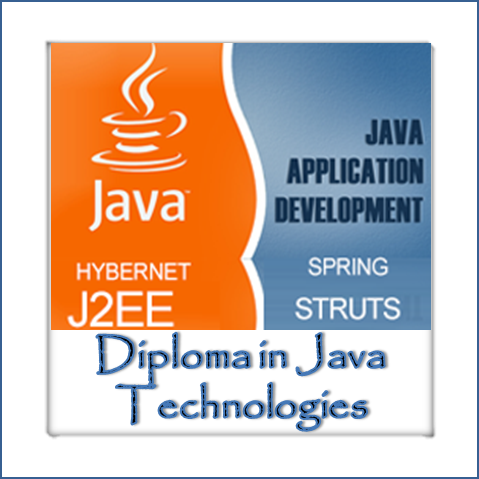
# Duration is 2 mth (4 hrs daily)
# Covers Java Programming in depth
# Java Project
# 100% Placement Support
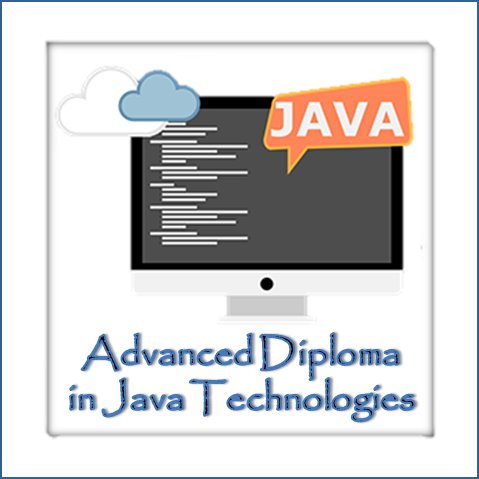
# Duration is 4 mth (4 hrs daily) or 3 mth (6 hrs daily)
# Covers entire syllabus of DJT and additional topics like Java Frameworks, HTML5, CSS3, JavaScript, Angular 8, etc.
# Softskills & Aptitude
# Project Incubation
# 100% Placement Support
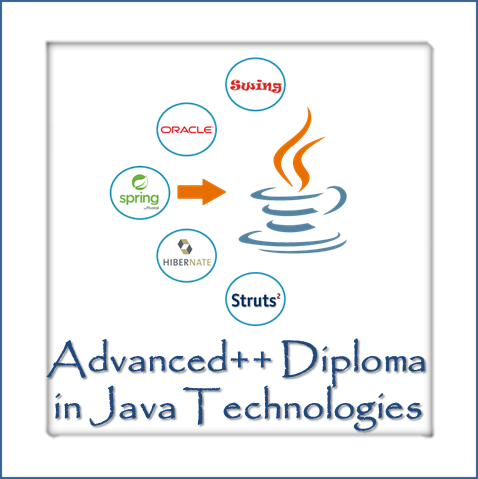
# Duration is 6 mth (4 hrs daily) or 4 mth (6 hrs daily)
# Covers entire syllabus of ADJT and additional topics like Software Testing, ExpressJS, NodeJS, MongoDB, Python, etc.
# Softskills & Aptitude
# Internship on Live Projects
# Internship letter
# Priority Placements
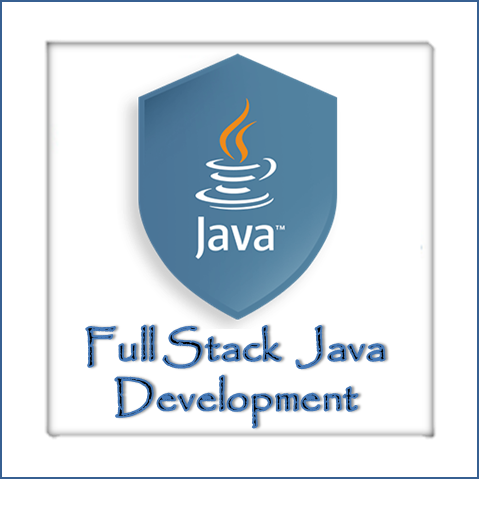
# Duration is 4 to 6 mth (4 hrs daily)
# Covers entire syllabus of ADJT OR ADJT++
# Softskills & Aptitude
# Internship on Live Projects / Project Incubation
# Priority Placements
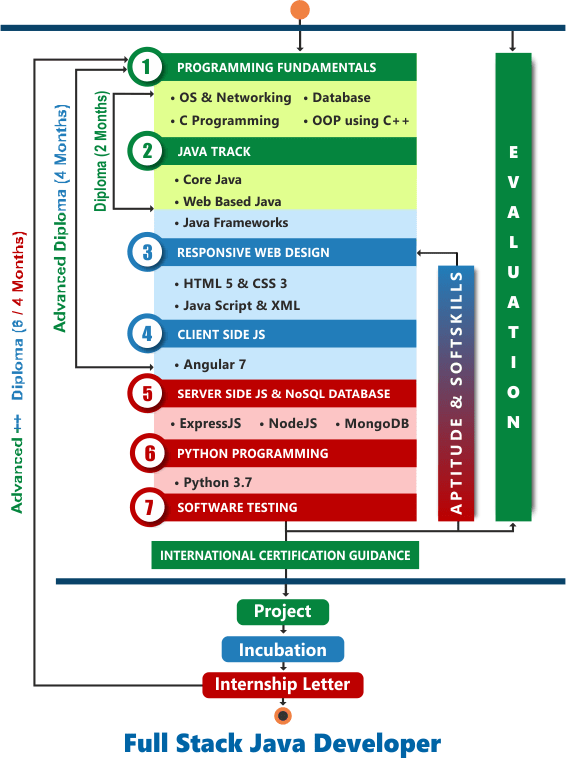
- Introduction to OS & Networking
- Overview of Operating System
- Concept of Process and Thread
- Memory Management
- Network Basics
- Classification of Networks
- Network Topologies
- Network Communication and Protocols
- TCP/IP fundamentals
- Introduction to Database and SQL
- Introduction to Database
- Normalization
- Introduction to SQL
- Creating and managing tables
- Retrieving data using SQL statement
- Built-in functions
- Summarizing results using group functions
- Joins
- Retrieving Data by using Sub-queries
- SET operators
- Manipulating data and transaction
- Managing other schema objects
- Managing objects with Data Dictionary Views
- Manipulating large DataSet
- Managing Data in Different Time Zones
- Programming in C
- Introduction to Programming
- Data Types, Operators
- Compilation, Linking, Execution, Debugging
- Integrated Development Environment
- Console Input and Output
- Control Structures
- Functions
- Pointers
- Storage classes, Dynamic Memory allocation
- Arrays, Strings
- File IO
- Structures and Unions
- Command Line arguments
- Macros
- Object Oriented Programming with C++
- Concepts of Object Oriented Programming
- Class and Object
- C++ as a better C
- Constructor, Constructor Overloading
- Static Data Member
- Static Member function, Inline function, Friend function
- Operator Overloading
- Inheritance
- Polymorphism
- File IO
- Exception Handling
- RTTI, Type Casting
- Templates
- Namespaces
- HTML 5.0
- HTML Basics: Structure, Elements and Attributes
- Various Input fields in html
- Tables, Frames, Lists, Layouts
- Fonts, Colors
- Images
- HTML Forms
- Cascading Style Sheet (CSS 3.0)
- Java Script
- Java Script Language basics
- Variables, Data Types, Functions, Operators
- Control flow using conditional and Iterative statements
- Managing HTML DOM and Events
- Java Script Objects
- XML
- XML Basics : Structure
- Elements and Attributes
- Introduction to Java
- What is Java?
- Need of Java Language
- Features of Java Language
- Setting Java Environment
- Working with Java
- Java architecture
- Concept of classLoader, JVM, JIT
- First Java Application
- Basics of Java
- Data types
- Variables, Literals etc.
- Operators in Java
- Java statements & types
- OOP's Concept
- What is OOP's
- Why we need OOP's
- What is Object?
- Object Charactristics
- Concept of Classes & Object creation in Java
- OOP's Features
- Abstraction & Encapsulation
- Explore java.lang package
- Access modifiers, static concept
- String Handling in Java
- Package programming
- OOP's Features
- Polymorphism & Inheritance
- Method overloading
- Inheritance & types using extends, super keyword
- Method overriding, final keyword
- Abstract class & Interface
- Java Misc Concept
- Inner class
- Reflection in Java
- Wrapper classes
- Exception Handling
- What is Exception
- Exception type & hierarchy
- Handling Exception using try-catch
- throw & throws
- Custom Exception
- Assertion
- Multithreading in Java
- Concept of Multitasking.
- What is Thread
- Thread Lifecycle & State
- Thread API
- Thread Priority
- Synchronization in Multithreading
- Inter thread communication
- I/O Programming & File Handling
- What is Stream?
- Types of Stream in Java
- ByteStream & concern classes.
- CharacterStream & concern classes
- Serilization in Java
- Overview on java.nio package
- GUI Programming
- What is GUI?
- Need of GUI Programming.
- Explore java.awt package
- Event Handling
- Layout management
- Swing programming
- Enhanced componenet of Swing.
- Collection Framework
- What is collection Framework?
- Need of Collection
- Collection using Generics
- Set & implemented classes
- List & implemented classes
- Map & implemented classes
- Comparable Vs Comparator
- JDBC Programming
- What is JDBC?
- Need of JDBC
- JDBC Driver & types
- JDBc architecture
- JDBC API
- Statement Vs PreparedStatement
- JDBC Transaction
- Networking in Java
- Advance JDBC
- What is Stored Procedure?
- JDBC using Stored Procedure
- ResultSetMetaData API
- DatabaseMetaData API
- Data Access Object Design Pattern
- JDBC application using Swing, DAO
- HTML & XML
- Overview on HTML
- HTML form tag & implementation
- Overview on XML
- CSS & JavaScript
- Overview on CSS
- Implementing CSS in HTML
- Overview on JavaScript.
- Overview on JEE
- Concept of Web Application
- Structure of Web Application
- Setting up Web application with Apache Tomcat
- Servlet Basics
- What is Servlet?
- Servlet Structure & LifeCycle
- Servlet API
- GenericServlet Vs HttpServlet
- Deployment Descriptor
- First Servlet application
- Servlet API
- ServletConfig vs ServletContext
- Servlet using JDBC
- RequestDispatcher & methods.
- Session Tracking in Java
- What is Session Tracking?
- Why we need Session Tracking?
- Session Tracking mechanism
- 1 Cookies
- 2 URL rewriting
- 3 Hidden Form Field
- 4 HttpSession
- ServletFiler API
- Java Server Pages (JSP)
- Introduction to JSP
- JSP Features over Servlet
- JSP Lifecycle
- JSP API
- JSP Tag
- JSP Scripting Element
- Decleration, Scriptlett, Expression tag
- JSP Directive Tag
- Page, include, taglib tag
- JSP Action tag
- Jsp implicit object
- JSP Specification
- Custom tag
- Expression Language
- JSTL in Jsp.
- Concept of MVC
- MVC Model 1
- MVC Model 2
- Frameworks in Java
- Struts2.x Framework
- ORM tool – Hibernate
- Spring Framework
- Introduction to Struts2.x
- Overview on MVC model
- MVC Model-1
- MVC Model-2
- Web Application Framework
- What is Struts 2
- Setting Up Struts 2 in Eclipse
- Writing a Struts 2 Hello World Application
- Struts 2 Workflow
- Practical on above point.
- Struts2.x Action
- Concept of POJO
- Action interface
- ActionSupport class
- Responsibilties of Action
- Aware intefaces
- Practical on above point.
- Struts2.x Tag
- UI Tag
- Data Tag
- Practical on above point.
- Validation in Struts2.x
- Validation in Action
- Validation Framework
- Custom Validators
- Practical on above point.
- Interceptor in Struts2.x
- Built-in Interceptor
- Custom Interceptor
- Practical on above point.
- Struts2.x Misc Concept
- ValueStack
- ActionContext
- OGNL
- Result Type
- Big picture of Struts2.x
- Practical on above point.
- Introduction
- Limitation with JDBC
- What is ORM?
- What is Hibernate?
- Hibernate Architecture
- Understanding Hibernate First Application
- Practical on above point.
- Hibernate Example
- CRUD Operation Using Hibernate
- Hibernate with Annonation
- Hibernate Generator classes
- Practical on above point.
- Hibernate Mapping
- Componenet Mapping
- Inhertance Mapping
- Practical on above point.
- Collection Mapping
- List
- one-to many by List
- Set
- one -to -many by Set
- Map
- many-to-many by Map
- Practical on above point.
- HQL & Criteria
- What is HQL?
- Understanding HQL with Application
- Problems with HQL
- What is Criteria
- Understanding Criteria with Application
- Practical on above point.
- Caching in Hibernate
- First level cache
- Second level cache
- Intergrate Struts2.x with Hibernate.
- Practical on above point.
- Introduction
- What is Spring?
- Spring Features
- Spring Modules
- Dependency Injection
- IoC container
- What is Bean?
- Spring First Application
- Practical on above point.
- Spring Core
- Collection Injection
- Method Injection
- Constructor Injection
- InnerBean
- Scope
- Practical on above point.
- Spring DAO
- Spring JDBCTemplate
- Spring HibernateTemplate
- Intergrate Sping with Hibernate.
- Practical on above point.
- Spring MVC
- Spring DispatcherServlet class
- Spring configuration
- Request Processing life cycle
- Spring MVC Hello World Example
- Spring MVC Form Handling Example.
- Practical on above point.
- Spring AOP
- What is Cross-cutting concern?
- Solution-Sping AOP
- AOP Terminology
- Aspect
- Joint Point
- Advice etc.
- Sping AOP Example.
- Practical on above point.
- Enterprise Java Project level Application.
- What is Angular?
- Single Page Application vs Server-side Web Applications
- Why Angular?
- Angular for complex, rich, enterprise application development
- AngularJS vs Angular JS 2 vs AngularJS 4
- Structure of AngularJS 4 Application
- Typescript Essentials
- Typescript as Programming Language for Angular
- Trans compilation, Debugging Typescript code
- Classes & Interfaces
- Const, Let, String Templates, For...of
- Arrow Functions
- Generics
- Namespaces
- Decorators
- Rest & Spread Operators
- Introduction to Components
- What Is a Component?
- Creating the Component Class
- Component hierarchy and wireframing
- Essential built-in directives
- Branching with ngIf
- Iteration with ngFor
- Class and style bindings
- [class.x] bindings
- [style.y] bindings
- [ngClass] for more complex class selection
- Component styling
- Scoped CSS
- ViewEncapsulation
- Targeting the component itself
- Component data dinding
- Bind data "downward" with @Input()
- Use events to send data upward with @Output
- Templates, Interpolation, and Directives
- Building a Template and the Component
- Using a Component as a Directive
- Angular Directives
- Directives Overview
- Attribute Directives
- Structural Directives
- ngmodel
- ngIf
- ngFor
- ngSwitch
- ng-template,etc.
- Custom Directive
- Binding with Interpolation
- Adding Logic with Directives: ngIf, ngFor
- Template binding expressions
- Null coalescing / safe traversal
- Events and event bindings
- Data Binding and Pipes
- Property Binding
- Handling Events with Event Binding and Input with Two-way Binding
- Transforming Data with Pipes
- Built-in Pipes
- Chaining Pipes
- Async Pipe
- Custom Pipe
- Components in Detail
- Defining Interfaces
- Encapsulating Component Styles
- Using Lifecycle Hooks
- Building Custom Pipes
- Relative Paths with Module Id
- Building Nested Components
- Passing Data to a Nested Component Using @Input and Data from a Component Using @Output
- Services and Dependency Injection
- Dependency injection
- Injection introduction
- Why dependency injection?
- What can be injected?
- Explaining DI
- Creating Services
- Injecting services into services
- Retrieving Data Using HTTP
- Observables and Reactive Extensions
- Sending an HTTP Request
- Exception Handling
- Subscribing to an Observable
- Loading data via HTTP
- Show async data via the async pipe
- Inject HTTP in to a service, not in to a component
- Setting request headers
- CORS discussion
- More unit testing
- Unit testing services
- Asyncronous testing
- Mocking HTTP responses
- Navigation and Routing Basics
- How Routing Works, Configuring
- Route parameters
- Route-driven observable data loading
- Route guards - protecting routes
- Resolve - loading data during routing
- Tying Routes to Actions
- Placing the Views
- Passing Parameters to a Route and Activating a Route with Code
- Protecting Routes with Guards
- Modules
- What Is an Angular Module?
- Bootstrap Array, Declarations Array, Imports Array, Exports Array
- Providers Array
- Feature Modules, Shared Module
- Revisiting AppModule
- Angular Forms
- Forms
- Controls, Control groups
- Form Builder
- Form Validation
- Applying Validation
- Custom Validation
- Data Binding in Angular Forms
- HTTP Form Posting and Data Access
- Third-party Form Controls
- Reactive Forms
- Angular Testing
- Angular & Unit Testing overview
- Jasmine, Karama Testing Tools
- Writing Unit Tests using Jasmine
- Running Test using Karma Test Runner
- Miscellaneous Concepts
- Progressive web apps
- Material Design components
- HttpClient API
- Multiple Export
- Node Js and Express Js
- Intro to Node.js
- NodeJS Basics & Global objects
- Node Modules
- File System
- Express Framework
- RESTful APIs
- How Node.js connects to databases
- Connecting to Mongodb databases
- Performing CRUD operations using Node.js
- MongoDB
- Introduction to MongoDB
- Mongo Shell
- CRUD using Mongo shell
- Index
- Aggregation
- Introduction
- Python Installation & working
- Variables & Basic Operators
- Data Types
- Declaring & using Numeric data types
- Using String data type & operation
- Defining List,use of Tuple data type
- Python Program
- Flow Control Conditional blocks using if, else & elif
- for loops, while loops in python
- String, list & dictionaries
- Functions, Modules & Packages
- Programming using functions, modules & external packages
- Organizing projects into modules
- Importing modules
- Understanding Lamda function
- String, List & Dictionary
- Understanding String in build methods
- List manipulation using in build methods
- Dictionary manipulation
- Programming using String, List and Dictionary in build functions
- Object Oriented Programming
- Concept of class, object & instances
- Constructor, class attributes & destructors
- Inheritance, Overlapping & Overloading operators
- Adding & retrieving dynamic attributes of classes
- Introduction to Software Applications
- What is Software Application
- Types of Software Applications
- Components of Software
- One Tier Architecture / Two Tier Architecture / Three Tier Architecture / Multi Tier Architecture
- Application Domains
- Application Models
- Software Development Life Cycle
- Phases of SDLC in detail
- Project Team Organization Structure
- Test Team Roles & Responsibilities
- Various Application Issues
- Waterfall Model
- Iterative Model
- Spiral Model
- Agile Model
- Introduction to Software Testing
- What is Software Testing ?
- 'V' model in detail
- Verification Techniques
- Reviews
- Inspections
- Walkthrough
- Validation
- Levels of Testing
- Unit Testing
- Integration Testing
- System Testing
- User Acceptance Testing
- Software Testing Life Cycle
- Requirements Analysis
- Test Planning
- Test Design
- Test Execution
- Test Closure
- Economics of Testing
- Testing Methodologies
- Black Box Testing
- Advantages & Disadvantages
- White Box Testing
- Statement Coverage
- Decision Coverage
- Test Design
- Test Scenarios
- Creating Test Scenarios from Use Case Diagram
- Test Cases
- Creation from Test Scenarios
- Test Case Template
- Test Case Review
- Requirement Traceability Matrix
- Test Case Management Tool
- Test Data
- Test Data Creation Techniques
- Boundary Value Analysis
- Equivalence Class Partitioning
- Error guessing
- Decision Table
- State Transition Testing
- Negative Testing
- Best Practices of Test Design
- Test Execution
- Test Environment Setup
- Smoke / Sanity Testing
- Test Case Selection for Execution
- Running Test Cases
- Logging Defects
- Retesting and Regression
- Challenges in Test Execution
- Test Closure Report
- Defect Management
- What is a Defect?
- Why do bugs occur?
- Defect Reporting
- Defect Report Template
- Defect Severity & Levels
- Defect Priority & Levels
- Defect Life Cycle
- Defect Tracking Tools
- Defect Prevention
- Types Of Non Functional Tests
- User Interface Testing
- Usability Testing
- Localization Testing
- Internationalization Testing
- Accessibility Testing
- Performance Testing
- Load Testing
- Endurance Testing
- Stress Testing
- Configuration Testing
- Compatibility Testing
- Installation Testing
- Security Testing
- Quality
- Software Quality Factors
- Quality Management Systems (QMS)
- Quality Assurance (QA) & Quality Control (QC)
- Plan – Do – Check – Act
- Testing Metrics
- Skills for a Professional Tester
- Importance of Communication Skills in Profession
- Group Discussions-Techniques Dos, Donts
- Interviews- Techniques, Dos, Donts, FAQs
- Mock GD’s & interviews
- Presentation Skills
- Resume Writing
- Numbers(HCF & LCM)
- Interests and Partnerships
- Ratio & Proportion
- Mixtures & Allegations
- Profit & Loss
- Time, Speed & Distance
- Time & Work
- Mensuration
- Permutations & Combinations
- Average
- Percentages
- Probability
- Coding-Decoding, Series
- Directions
- Blood Relations
- Clocks & Calenders Verbal
- Analogy & Odd Man Out
- Antonyms & Synonyms
- Reading Comprehension
- One Word substitution & Idioms phrase
- Technical Assignments
- Technical Test
- Technical Interview
Enquiry
Proficiency after this course
On completion of Full Stack Development Java course
- You will be able to apply for Full Stack developer position
- Demonstrate excellent Java coding abilities to your future employers
- You will be able to develop end to end Application
- Test and deploy code
- You acquire essential knowledge on Front and Back End Development
- Build real-world professional, beautiful and truly responsive websites
Why join Profound for Full Stack Developer Java Course?
- Strong focus on Placement and proven track record of placed students with MNCs in the field of Full Stack Java.
- Full Stack Developer Java Course contents have been designed by understanding the need of Industry and level of Fresher / student. Which makes Duration and Contents of course intensive than any other Full Stack Development Classes.
- One on One attention by Trainers fulfilling need of every student.
- Well equipped Class rooms available for Concept Sessions, Project discussions, Presentations, Brain storming giving feel of Corporate Environment
- Ample Lab facility available free of charge for exploring world of Full Stack Development.
- Extensive practical hands-on on every Topic guided by a Lab Trainer which helps in removing coding fear of a student.
- Design and Development of deadline oriented Real time projects under guidance of Experts provides feel of how to survive in competitive world.
- Exhaustive tests on each concept, on-line MCQ tests practice raises student's confidence in facing Recruitment exams held by Companies.
- Along with Technical competence, emphasis given for preparing Fresher on Interview skills and other Soft skills.
- Sincere efforts to build Technical competency in Fresher to make him Employable in Industry.
 Batch Schedule
Batch Schedule Download Brochure
Download Brochure